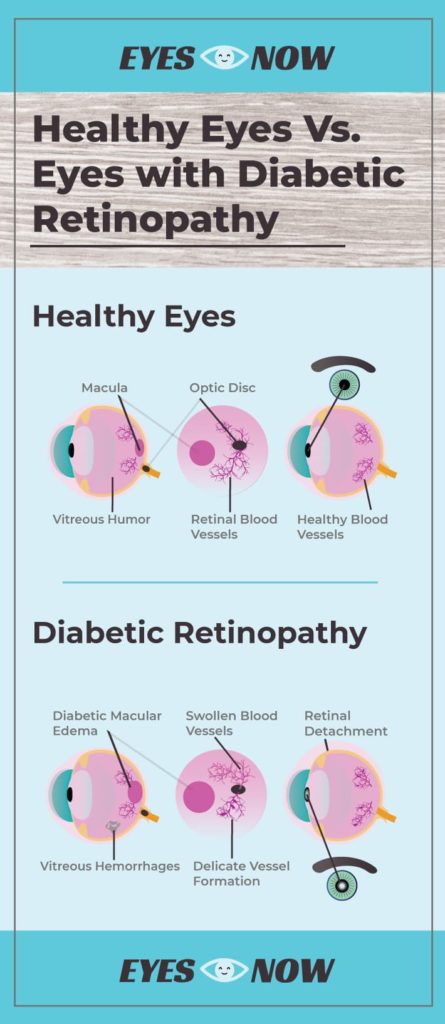According to the CDC, 1 in 10 people (about 34 million) in the United States has diabetes and about 88 million more live with prediabetes. And although diabetes is relatively common in our country, this doesn’t make the disease any less life-changing.
But many people might not understand how exactly diabetes can affect their health, and more specifically, how it can affect their eye health. The team at Eyes Now is committed not only to providing leading eye care solutions, but we are also driven by educating our patients on how their overall health can play a part in their eye care.
Today, we’re going to take a deep dive into diabetes and the role it plays in ocular health. However, not everyone’s symptoms are the same, so it’s essential to get regular eye exams to help manage the effect diabetes can have on your vision.
What is Diabetes?
Diabetes is a systemic disease that impacts how your body processes sugar, or glucose, in your bloodstream. When your blood sugar levels rise after eating, insulin is released, allowing the sugar to enter your blood cells and give you energy. However, diabetes can prevent your body from producing insulin or even stop cells from responding to it.
As a result, the increased blood sugar level raises the risk of heart disease, kidney disease, and even eye disease.
Diabetes cannot be cured, but it can be controlled with regular insulin injections and monitoring your blood sugar levels. Generally, the easiest course of action for managing the disease is to eat healthy foods and exercise often.
There are 4 types of diabetes:
- Type 1 Diabetes is an autoimmune disease that destroys cells in the pancreas, where insulin develops.
- Type 2 Diabetes affects the body’s ability to produce insulin.
- Prediabetes is when your blood sugar levels are higher than average but isn’t high enough to be diagnosed as type 2 diabetes.
- Gestational diabetes occurs when you have diabetes while pregnant. Hormones produced by the placenta can block the production of insulin.
Symptoms
Some of the most common symptoms you may experience with diabetes include:
- Increased levels of thirst
- Extreme hunger
- Ketones in your urine
- Frequent urination
- Fatigue and irritability
- Blurry vision
How Does it Affect Your Eyes?
With excess sugar levels in your bloodstream, the sugar will eventually go through the blood vessels located at the back of your eye and damage them. Damaged blood vessels can lead to various eye problems, including:
Diabetic Retinopathy
Diabetic retinopathy is one of the more common eye diseases patients with diabetes can develop. It occurs when the sugar damages the blood vessels at the back of your eye, an area otherwise known as the retina.
There are 2 versions of diabetic retinopathy you may develop:
Non-Proliferative Diabetic Retinopathy
Non-proliferative diabetic retinopathy (NPDR) is the most common version of the disease, and it generally occurs when the walls of your retina’s blood vessels start to weaken. When this happens, they can bulge or leak fluids into your retina, leading to a gradual loss of vision over time.
Proliferative Diabetic Retinopathy
Proliferative diabetic retinopathy (PDR) is far more serious and can lead to more severe symptoms, like retinal detachment.
PDR occurs when the blood vessels inside your retina are damaged to the point where they seal off completely, forcing your retina to compensate by creating abnormal blood vessels. These vessels are quite delicate, and fluids from them can leak into your vitreous, causing floaters.
Over time, the new vessels can create scar tissue on your retina, increasing the chances of experiencing retinal detachment and permanent vision loss.

Diabetic Macular Edema
Diabetic macular edema is a complication of diabetic retinopathy. As the vessels in your retina leak, the fluids can cause your macula (a central part of your retina responsible for central vision) to swell. Over time, this can also lead to permanent vision loss.
Open-Angle Glaucoma
According to the National Eye Institute, you are twice as likely to develop open-angle glaucoma if you have diabetes. Some research has shown that diabetes could cause blood vessels to form on the iris, affecting your intraocular fluids’ drainage system and leading to increased intraocular pressure (IOP). High IOP levels damage your optic nerve, leading to permanent vision loss.
Cataracts
People with diabetes are also more likely to develop cataracts at an early age. A cataract is an eye condition that causes the clear crystalline lens of your eye to become rigid. As this happens, the lens will develop a hazy, milky look that can distort and impair your vision. According to researchers, cataracts are the leading cause of blindness in the United States.
Managing Your Eye Health
If you have diabetes, the very first thing you should do is make sure you’re having annual eye exams. Our technologically advanced eye examinations take a detailed look at your eye’s health and can spot the signs of eye disease before you notice any symptoms.By catching these issues early, we can help develop a management plan that suits your needs and preserves your vision. Start protecting your eyes and book your appointment with the team at Eyes Now today.


